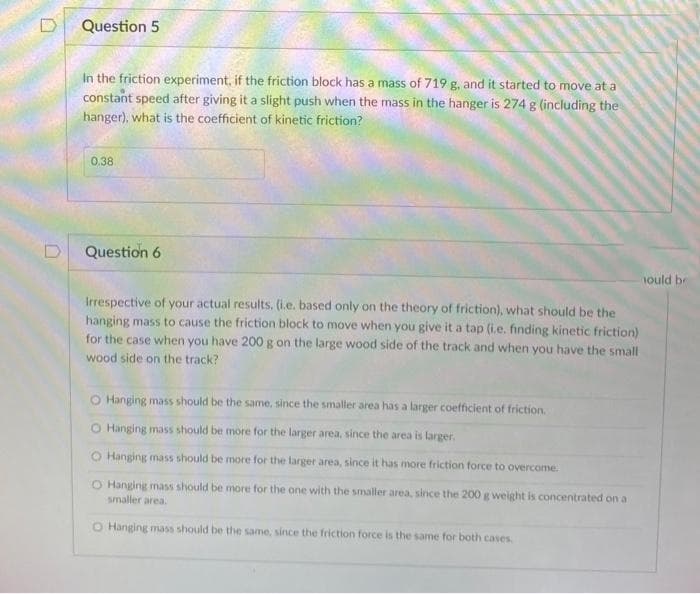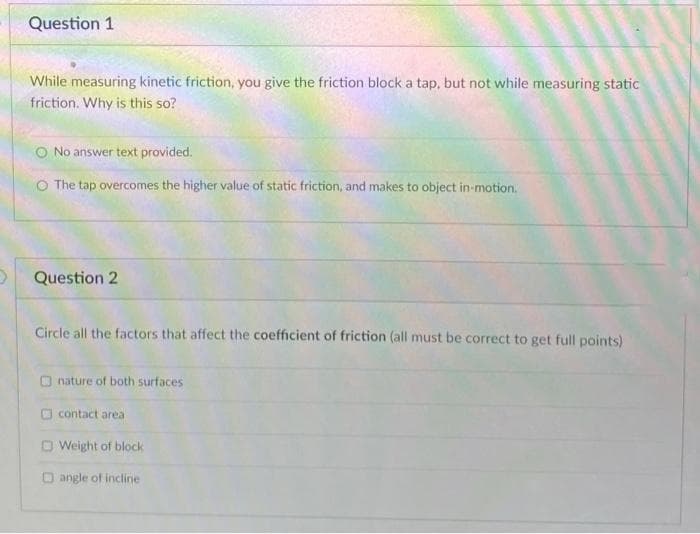Question 5 In the friction experiment, if the friction block has a mass of 719 g, and it started to move at a constant speed after giving it a slight push when the mass in the hanger is 274 g (including the hanger), what is the coefficient of kinetic friction? 0.38 Question 6 ould be Irrespective of your actual results, (i.e. based only on the theory of friction), what should be the hanging mass to cause the friction block to move when you give it a tap (i.e. finding kinetic friction) for the case when you have 200 g on the large wood side of the track and when you have the small wood side on the track? O Hanging mass should be the same, since the smaller area has a larger coefficient of friction. O Hanging mass should be more for the larger area, since the area is larger. O Hanging mass should be more for the larger area, since it has more friction force to overcome. O Hanging mass should be more for the one with the smaller area, since the 200 g weight is concentrated on a smaller area. O Hanging mass should be the same, since the friction force is the same for both cases.
Question 5 In the friction experiment, if the friction block has a mass of 719 g, and it started to move at a constant speed after giving it a slight push when the mass in the hanger is 274 g (including the hanger), what is the coefficient of kinetic friction? 0.38 Question 6 ould be Irrespective of your actual results, (i.e. based only on the theory of friction), what should be the hanging mass to cause the friction block to move when you give it a tap (i.e. finding kinetic friction) for the case when you have 200 g on the large wood side of the track and when you have the small wood side on the track? O Hanging mass should be the same, since the smaller area has a larger coefficient of friction. O Hanging mass should be more for the larger area, since the area is larger. O Hanging mass should be more for the larger area, since it has more friction force to overcome. O Hanging mass should be more for the one with the smaller area, since the 200 g weight is concentrated on a smaller area. O Hanging mass should be the same, since the friction force is the same for both cases.
Related questions
Question
12

Transcribed Image Text:Question 5
In the friction experiment, if the friction block has a mass of 719 g, and it started to move at a
constant speed after giving it a slight push when the mass in the hanger is 274 g (including the
hanger), what is the coefficient of kinetic friction?
0.38
Question 6
nould be
Irrespective of your actual results, (i.e. based only on the theory of friction), what should be the
hanging mass to cause the friction block to move when you give it a tap (i.e. finding kinetic friction)
for the case when you have 200 g on the large wood side of the track and when you have the small
wood side on the track?
O Hanging mass should be the same, since the smaller area has a larger coefficient of friction.
O Hanging mass should be more for the larger area, since the area is larger.
O Hanging mass should be more for the larger area, since it has more friction force to overcome.
O Hanging mass should be more for the one with the smaller area, since the 200 g weight is concentrated on a
smaller area.
O Hanging mass should be the same, since the friction force is the same for both cases

Transcribed Image Text:Question 1
While measuring kinetic friction, you give the friction block a tap, but not while measuring static
friction. Why is this so?
O No answer text provided.
O The tap overcomes the higher value of static friction, and makes to object in-motion.
Question 2
Circle all the factors that affect the coefficient of friction (all must be correct to get full points)
O nature of both surfaces
O contact area
D Weight of block
O angle of incline
Expert Solution
This question has been solved!
Explore an expertly crafted, step-by-step solution for a thorough understanding of key concepts.
This is a popular solution!
Trending now
This is a popular solution!
Step by step
Solved in 2 steps with 1 images
